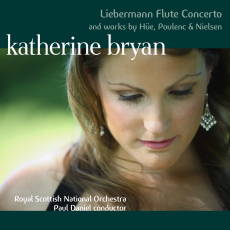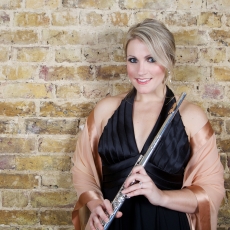Katherine Bryan - Liebermann Flute Concerto - Audiophile Audition
How nice to come across an album in which the featured work - though by a contemporary composer - is just as tonal as those by the other three composers. In fact, in some ways the Nielsen Flute Concerto sounds the least tonal of all four. These are all lovely works for flute and orchestra that show off that combination in just as enjoyable a fashion as any violin or piano concerto. And when you have the virtuoso playing of Ms. Bryan, the excellent support of the Royal Scottish National Orchestra, and the top-flight hi-res surround provided by Linn, you have a really winning product.
Lowell Liebermann's three-movement concerto followed on his earlier Sonata for Flute and Piano and a Sonata for Flute and Guitar, so his overtly tonal Flute Concerto has a fine grasp of the particular abilities of the instrument and has become a favorite of flutists around the world. The Moderato opening movement offers a beginning repetitive theme in the strings which is then heard in a series of variations during the rest of the movement. The middle movement is serene and lyrical, developing the pastoral qualities at which the flute excels. The closing Presto movement is a virtuoso workout in a rondo-like form.
Georges Hüe's short Fantaisie has been part of the flute repertory for almost a century, but its delights were new to me. Especially attractive to my ears are the excursions into impressionism - sounding sometimes almost like a companion to Debussy's Prelude to the Afternoon of a Faun. Poulenc's chamber works for woodwinds are some of the gems of French music. His Sonata for Flute and Piano has had many performances and recordings, along with his similar sonatas for oboe and for clarinet. Flutist James Galway commissioned composer Lennox Berkeley to arrange the Flute Sonata into a Flute Concerto in 1976. British composer Berkeley was much influenced by French music and Poulenc had been an influence on him, so the choice was perfect. Over the course of its three movements, the new concerto lets the solo flute portray a variety of different emotions and moods, but supported by the richer orchestral textures. The first movement moves constantly between major and minor, and closing Presto giocoso movement is fast and jolly. The translation to a concerto is so successful that I think it will become my favored version of this work.
Nielsen's Flute Concerto of 1926 has had a number of recordings. In just two movements, it emphasizes the idyllic qualities of the flute, giving it a free, improvisatory style. Thruout the work the bass trombone of the orchestra acts almost as a nemesis of the flute, in an interplay between the two instruments not without humor.With the improved presence and realism of the solo instrument and the clearer spatial separation between it and the orchestra, I find most any concerto recording to be a better experience on multichannel SACDs, and this one is no exception. The note booklet is also well-written and to the point. Bravo Linn for a fine addition to the SACD discography.

